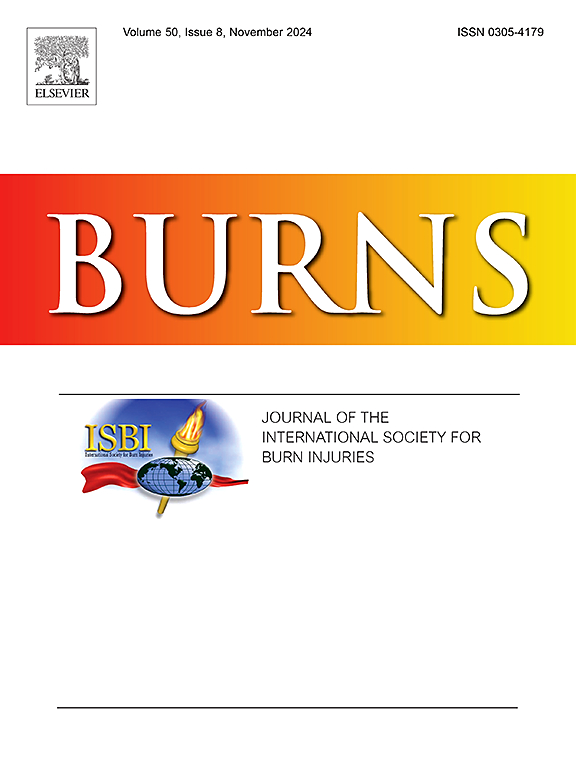选择性去污在烧伤患者的消化道:系统回顾与荟萃分析
IF 3.2
3区 医学
Q2 CRITICAL CARE MEDICINE
引用次数: 0
摘要
在重症监护病房(ICU)的机械通气成人患者中,选择性消化道净化(SDD)已被证明可以降低感染风险并提高生存率。虽然SDD在这一人群中的益处已被证实,但对于感染风险增加且具有明显临床特征的烧伤患者,是否也能获得类似的益处尚不清楚。在这篇系统综述中,我们的目的是评估给烧伤患者施用SDD的理想和不理想的患者重要影响。方法/设计我们对随机临床试验(rct)进行了系统回顾和荟萃分析,评估SDD与安慰剂或无SDD对烧伤患者的影响。主要终点为30天死亡率。次要结局包括严重不良事件、抗微生物药物耐药性、肺炎、血流感染、无ICU和住院天数以及90天死亡率。我们检索了所有主要的数据库,并遵循Cochrane协作和系统评价和荟萃分析指南的首选报告项目提供的建议。证据的确定性根据分级建议评估、发展和评价方法进行评估。结果我们纳入4项随机对照试验,共纳入457例烧伤患者。所有的试验都被评估为存在“一些担忧”或“高风险”的偏倚。所有评估结果的证据都非常不确定。死亡率方面,相对危险度(RR)为0.62(95 %可信区间(CI) 0.22-1.78, I2 = 75 %,随机效应模型(REM),极低确定性证据)。肺炎的RR为0.75(95 % CI 0.48-1.19, I2 = 0 %,固定效应模型,极低确定性证据)。对于血液感染,RR为1.10(95 % CI 0.71-1.69, I2 = 0 %,REM,非常低确定性证据)。对于住院时间,平均差异为- 2.03天(95 % CI - 9.64-5.59, I2 = 51 %,REM,非常低确定性证据)。由于数据有限或没有数据,我们没有对其余次要结局进行荟萃分析。由于纳入试验的总参与者和事件数量不足,无法进行试验序列分析。结论我们发现SDD对烧伤患者重要预后的影响证据的确定性很低。在更多烧伤患者的随机对照试验数据出现之前,从机械通气成人ICU患者的证据进行推断可能是合理的。本文章由计算机程序翻译,如有差异,请以英文原文为准。
Selective decontamination of the digestive tract in burn patients: A systematic review with meta-analysis
Background
In mechanically ventilated adult patients in the intensive care unit (ICU), selective decontamination of the digestive tract (SDD) has been shown to reduce the risk of infections and improve survival. While the benefits of SDD have been documented in this population, it remains unclear whether burn patients, who are at increased risk of infection and have distinct clinical characteristics, may experience similar benefits. In this systematic review we aimed to assess the desirable and undesirable patient-important effects of administering SDD to burn patients.
Methods/design
We conducted a systematic review with meta-analysis of randomized clinical trials (RCTs) assessing the effects of SDD versus placebo or no SDD in burn patients. The primary outcome was 30-day mortality. Secondary outcomes included serious adverse events, antimicrobial resistance, pneumonia, blood stream infections, ICU- and hospital-free days, and 90-day mortality. We searched all major databases and followed the recommendations provided by the Cochrane Collaboration and the Preferred Reporting Items for Systematic Reviews and Meta-Analyses guidelines. The certainty of evidence was assessed according to the Grading of Recommendations Assessment, Development, and Evaluation approach.
Results
We identified four RCTs with a total of 457 burn patients. All trials were assessed as having either ‘some concerns’ or ‘high risk’ of bias. The evidence was found to be very uncertain across all outcomes assessed. For mortality, the relative risk (RR) was 0.62 (95 % confidence interval (CI) 0.22–1.78, I2 = 75 %, random-effects model (REM), very low certainty evidence). For pneumonia, the RR was 0.75 (95 % CI 0.48–1.19, I2 = 0 %, fixed-effect model, very low certainty evidence). For bloodstream infections, the RR was 1.10 (95 % CI 0.71–1.69, I2 = 0 %, REM, very low certainty evidence). For hospital length of stay, the mean difference was −2.03 days (95 % CI −9.64–5.59, I2 = 51 %, REM, very low certainty evidence). We did not perform meta-analyses for the remaining secondary outcomes due to limited or no data. Trial sequential analysis could not be performed due to insufficient number of total participants and events in the included trials.
Conclusion
We found that the certainty of evidence is very low about the effects of SDD on patient-important outcomes in burn patients. Extrapolating from the evidence on mechanically ventilated adult ICU patients may be reasonable until more data from RCTs in burn patients emerge.
求助全文
通过发布文献求助,成功后即可免费获取论文全文。
去求助
来源期刊

Burns
医学-皮肤病学
CiteScore
4.50
自引率
18.50%
发文量
304
审稿时长
72 days
期刊介绍:
Burns aims to foster the exchange of information among all engaged in preventing and treating the effects of burns. The journal focuses on clinical, scientific and social aspects of these injuries and covers the prevention of the injury, the epidemiology of such injuries and all aspects of treatment including development of new techniques and technologies and verification of existing ones. Regular features include clinical and scientific papers, state of the art reviews and descriptions of burn-care in practice.
Topics covered by Burns include: the effects of smoke on man and animals, their tissues and cells; the responses to and treatment of patients and animals with chemical injuries to the skin; the biological and clinical effects of cold injuries; surgical techniques which are, or may be relevant to the treatment of burned patients during the acute or reconstructive phase following injury; well controlled laboratory studies of the effectiveness of anti-microbial agents on infection and new materials on scarring and healing; inflammatory responses to injury, effectiveness of related agents and other compounds used to modify the physiological and cellular responses to the injury; experimental studies of burns and the outcome of burn wound healing; regenerative medicine concerning the skin.
 求助内容:
求助内容: 应助结果提醒方式:
应助结果提醒方式:


